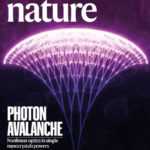The diffraction limit is a fundamental property of light that has long prevented optical microscopes from bringing into focus anything smaller than half the wavelength of visible light (~200 nanometers), which is at least an order of magnitude larger than the tiny protein machines that keep cells, and us, running. A team of researchers co-led scientists in Berkeley Lab’s Molecular Foundry and Columbia University’s school of engineering developed a new class of crystalline material that, when used as a microscopic probe, overcomes the diffraction limit without heavy computation or a super-resolution microscope. The amazing new material, called avalanching nanoparticles (ANPs), will advance high-resolution, real-time bio-imaging of a cell’s organelles and proteins, as well as the development of ultrasensitive optical sensors and neuromorphic computing that mimics the neural structure of the human brain, among other applications. The work was reported in a cover article in the journal Nature.
Was this page useful?
Send



